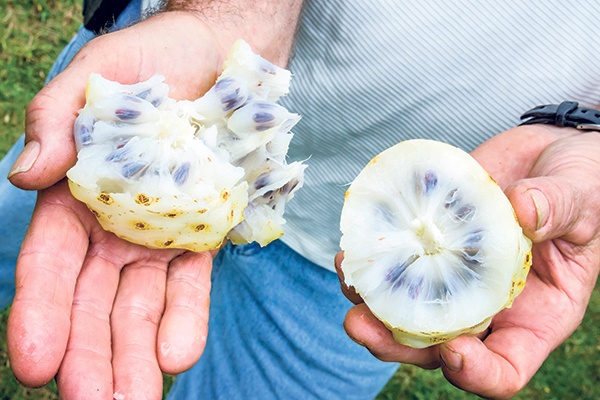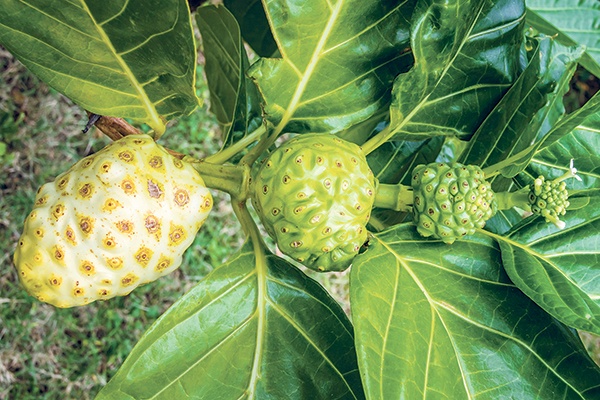Recently, Hawaiian Health Ohana changed its name to Hawaiian Organic Noni. But since 1981, the certified organic farm has been growing thousands of noni trees on 37-acres in Moloaa. The farm generates 75 percent of its energy through windmills and
Recently, Hawaiian Health Ohana changed its name to Hawaiian Organic Noni. But since 1981, the certified organic farm has been growing thousands of noni trees on 37-acres in Moloaa. The farm generates 75 percent of its energy through windmills and solar panels. Water for food processing comes from a well, compost is made onsite, foliar spray fertilizers are used and no-till methods preserve biological activity in the soil.
Owner Steve Frailey pioneered the production of unfermented, raw fruit leather and lotion made from pure noni pulp and juice. Leather is consumed orally in daily 2-inch square servings. Lotion is combined with lavender and grapefruit oil and used topically. Both leather and lotion are available for pets and humans.
Noni
Noni has been used as a principal medicine in Polynesian culture for 2,000 years. Traditionally, raw noni was eaten for coughs, colds, pain, liver disease, malaria, hypertension and intestinal worms. Topically it was used for sprains, swelling, bruises and wounds.
Today, most people consume noni juice, which is fermented. Although fermentation is a plus for some foods, in the case of noni, it looses antioxidant potential. Also, important antioxidants are from pulp, not juice. Based on comparable serving sizes, noni leather is 13.91 times more potent than commercial juice.
Antioxidants slow the oxidative process and free radical damage that contribute to age-related degeneration and disease. The National Institutes of Health developed Oxygen Radical Absorbance Capacity (ORAC) as a way to measure the antioxidant capacity of foods. Results from UBE Analytical Laboratories in Fullerton, California, found Hawaiian Organic Noni leather to have an ORAC score of 340,000 per serving. Apples score 3,082, pomegranates 3,037, blueberries 2,400 and raisins score 3,087.
Season: Seeds take up to four months to germinate, two years to grow into an eight-foot tree, and another five years to get good fruit.
“They’re extremely hardy,” says Frailey, who harvests noni fruit year-round. “All the trees need are mulch, good air flow and water.”
What to look for:
Fruit go from hard green to hard white. When ripe, the fruit is soft and translucent like a tomato.
Storage
Once ripe, noni will last two to three days in the refrigerator.
Preparation
Traditionally, noni has been eaten like an apple. This is tricky for most people, because the taste and smell is compared to blue cheese and stinky feet. Noni is not consumed for pleasure, it is strictly consumed for its healing properties.
Health benefits
Noni has been proven to be effective in decreasing joint destruction and pain caused by arthritis; it has a hypotensive effect that lowers blood pressure; is beneficial to diabetics because it lowers cholesterol, triglycerides and blood sugar; reduces oxidative stress; contains anti-inflammatory, antibacterial, anti-fungal activities; is 75 percent as strong as morphine; has anti-depressive and anti-anxiety properties; promotes a sense of well being, and has no side effects.
Testimonials from Hawaiian Organic Noni users say it has healed Lyme disease, ulcers, irritable bowel syndrome and periodontal disease; improves digestion, reduces blood sugar, provides pain relief from arthritis, rejuvenates skin (wrinkles, acne, eczema, psoriasis, ulcers, sunburn), and eases fibromyalgia symptoms.
We use noni in our household everyday. The lotion has healed carpal tunnel in my right arm due to writing. Lucy, our 12-year-old dog, developed a massive tumor as an allergic reaction to a leptospirosis shot, which grew back after it was surgically removed. After three months on noni, the new tumor disappeared. She also has arthritis in her left hip, which is alleviated with daily doses of noni lotion in her food.
Former University of Hawaii sports trainer Melody Toth used IcyHeat Lavender Noni Lotion on her athletes for tired legs, bone spurs, arthritis, repetitive trauma, ankle support and low back pain as well as quadriceps and hamstring injuries.
Hawaiian Organic Noni products can be found at:
Farmers Markets: Tuesday, Waipa (2 to 5 p.m.) and Coconut Market Place (9 a.m. to noon); Wednesday, Kauai Culinary Market (3:30 to 6 p.m.); Thursday, Coconut Market Place (9 a.m. to noon); Saturday, Kauai Community Market (9 a.m. to 1 p.m.), Namahana (9 a.m. to noon), and Hanalei (9 a.m. to noon). Luau Kalamaku at Kilohana Plantation (4:30 to 6 p.m.) Organic Noni Farm & Wellness Tours are every Monday, Wednesday and Friday at 10 a.m. by reservation only. For more information, visit Real-Noni.com.
•••
Marta Lane, a food writer on Kauai since 2010, offers farm to fork food tours and is the author of Tasting Kauai: Restaurants – From Food Trucks to Fine Dining, A Guide to Eating Well on the Garden Island. Information: TastingKauai.com




